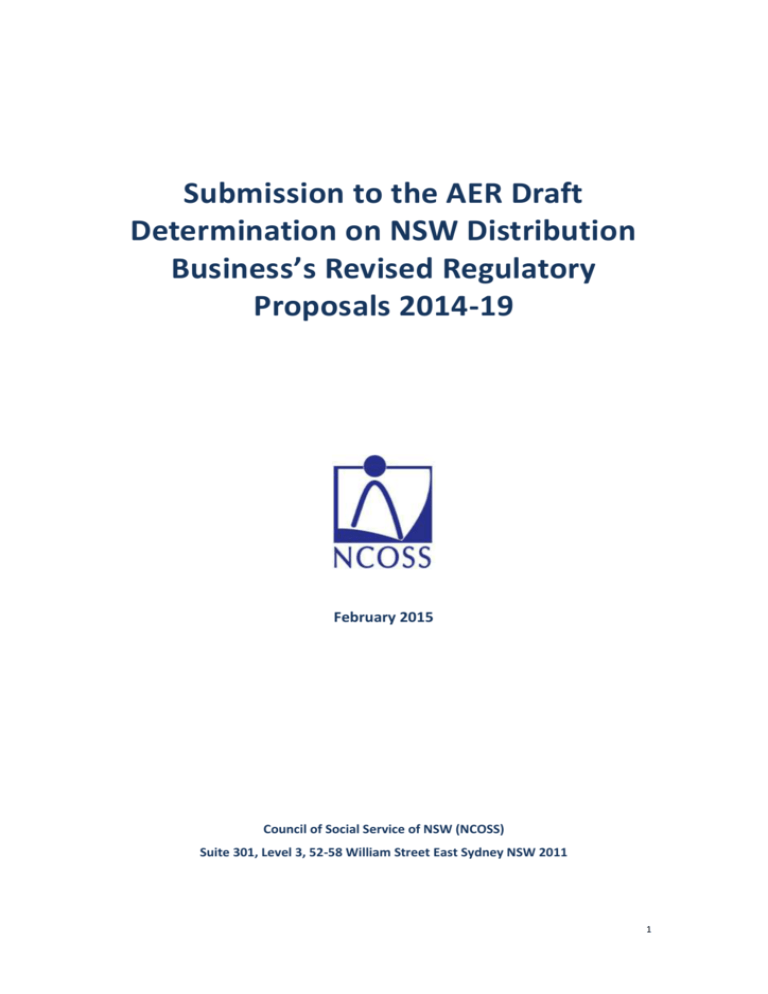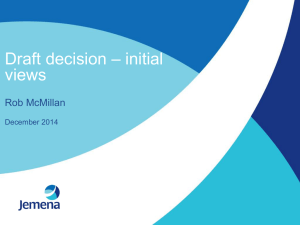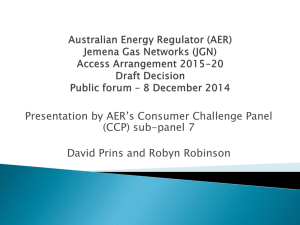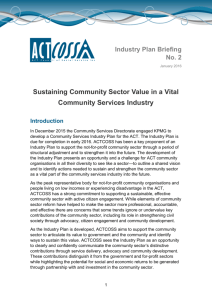Submission on draft decision and revised regulatory proposal
advertisement

Submission to the AER Draft Determination on NSW Distribution Business’s Revised Regulatory Proposals 2014-19 February 2015 Council of Social Service of NSW (NCOSS) Suite 301, Level 3, 52-58 William Street East Sydney NSW 2011 1 About NCOSS The Council of Social Service of NSW (NCOSS) is a peak body for the not-for-profit community sector in New South Wales. NCOSS provides independent and informed policy advice, and plays a key coordination and leadership role for the sector. We work on behalf of disadvantaged people and communities towards achieving social justice in NSW. Executive Summary NCOSS welcomes and supports the AER’s recent decision in respect of the three NSW distribution network businesses, in particular the downward revenue adjustments made as a result of: substituting an amount for both augmentation and replacement capex; revising the base year costs used for opex calculations to reflect efficient costs; disallowing step changes for operating expenditure, in particular “dis-synergy costs” and costs to assist businesses to transition to a more efficient cost base; removing the metering exit fee and reclassifying residual meter costs as standard control rather than alternative control; and, rejecting the businesses’ deviations from the rate of return guidelines. However, NCOSS notes concerns over two aspects of the current decision: the rejection of the broad based demand management programs proposed by Ausgrid; and, the generous rate of return allowed to the businesses as a result of the application of the current rate of return guidelines. Introduction NCOSS welcomes the opportunity to make comment on the AER draft determinations on the New South Wales electricity distribution businesses’ proposals. For some time NCOSS has been concerned about the impact of high electricity prices on low-income customers. Nearly 33, 000 households were disconnected for failure to pay an electricity bill in 20141, a figure that has risen a staggering 100% over the 5 years of the previous regulatory period2 and which is no doubt related to prices rising on average 70% during that time. Economic regulation of the monopoly network distribution businesses plays a key role in ensuring the affordability of energy now and into the future by keepings costs at no more than Australian Energy Regulator, Annual report on the performance of the retail energy Market, 2013-14, November 2014, p36. 2 ibid. 1 2 the efficient level of service provision. While the massive price hikes of the previous regulatory period in NSW must be seen a serious systemic failure, NCOSS is pleased that recent reforms to the National Electricity Rules, and the AER’s Better Regulation program have provided a framework for more sensible determinations and outcomes for NSW consumers. Upon review, NCOSS strongly supports the AER’s recent draft determinations in relation to Ausgrid, Endeavour Energy and Essential Energy. NCOSS notes that the AER has proposed reducing the revenues of all three businesses between 24% and 28%. The resulting impact on household bills of between $159 and $346 per annum will bring some relief to struggling households, particularly in regional areas where prices have been up to 26% higher3 and consumers have undoubtedly paid for having one of the least efficient service providers in the National Energy Market (NEM). This is a much better outcome than the CPI level prices increases that the distribution businesses had proposed as the best possible outcome. NCOSS believes any increase in prices based on the elevated revenues of the previous period would have been unacceptable, given the unprecedented level of revenue growth and corresponding price pain for consumers during this period. Changed economic conditions, revised reliability standards, and significantly reduced demand forecasts also support a lowering of costs to consumers in the new period. For these reasons, NCOSS is both surprised and concerned by the revised proposals submitted by the businesses, noting that only Ausgrid is proposing a lower overall expenditure while both Essential Energy and Endeavour Energy have increased their overall forecasts. We particularly welcome the AER’s consideration of the extent to which consumer input has been sought and taken into account in the businesses’ proposals, noting that this is one of the factors the AER may take into account in deciding whether the businesses have met the capital (capex) and operating (opex) expenditure criteria under the National Electricity Rules. We appreciate the comments made by the AER in relation to the deficiencies in the consumer engagement processes leading to the publication of the regulatory proposals, and believe this will help ensure that businesses do not view these requirements as token in the future. As noted in our previous submission to the AER on the businesses’ regulatory proposals, we look forward to the improved consumer engagement processes that all three businesses have committed to in the future. In the remainder of this submission we will comment on both the AER’s draft decision and the NSW distribution businesses revised proposals in each of the three Australian Energy Regulator, Annual report on the performance of the retail energy market, 2013-14. Op Cit. p 47. 3 3 key areas of the revenue building block, and also in relation to costs related to the newly established metering asset base. AER Draft Decision on the Businesses’ Capital Expenditure Proposals In relation to capex, NCOSS observes that the AER was not satisfied that any of the three proposals met the expenditure criteria and has therefore substituted the revenue proposals with AER estimates resulting in significantly reduced capex allowances of between 26% and 43%. NCOSS understands that the AER applied a “top down” approach using established metrics (for example capex per customer and capex per maximum demand) in order to test the efficiency of the “bottom up” developed revenues that the businesses are proposing. NCOSS supports this approach of establishing efficiency benchmarks to assess the reasonableness of the base costs claimed by distributors. While the capex proposals made were significantly reduced from the previous period, as the AER points out they were nonetheless on average higher than in the period from 2002. NCOSS agrees that the previous regulatory period should not provide an unscrutinised base line for comparative purposes. NCOSS notes also that allowances for augmentation have been reduced not only due to revised demand forecasts submitted by the businesses, but also due to engineering advice that efficiencies could be achieved through risk based cost benefit analysis assessment techniques. NCOSS supports the view of the AER that there is additional capacity in the network that should be used more efficiently. NCOSS notes that the largest contribution to the reduced capex allowances results from the AER rejecting the claims made by the businesses for replacement of assets. NCOSS supports the specific reductions here, noting that the businesses had significantly increased their claims for replacement capex relative to the previous period, and as the AER notes, such claims were between 40 – 55% higher than the long term average spending of the businesses to date. Given that there is no evidence that the average age of their assets has been declining, and given the extraordinarily high levels of spending on asset augmentation in the previous period, NCOSS believes the claims for additional expenditure are not justified. NCOSS appreciates the AER’s efforts to obtain detailed engineering advice and to undertake predictive modelling to make significant reductions to these allowances. NCOSS notes that all three businesses have submitted slightly lower capex proposals as a result of the AER’s draft decision, with Ausgrid providing the greatest reduction. 4 These downward revisions fall short of our expectations, however we are not able to assess the arguments the businesses have put for maintaining a higher expenditure than the substituted one provided by the AER, and will therefore leave that assessment to the AER. AER Draft Decision on the Businesses’ Operating Expenditure Proposals. NCOSS observes that the AER has proposed replacement revenues for each of the businesses’ operating expenditure that results in reductions of between 22.1% and 39.1%. NCOSS understands that the AER is not satisfied that the current proposals meet the expenditure criteria, as they do not reflect the costs that a prudent and efficient operator might reasonably incur. We understand that the AER’s revised revenue calculation result from adjusting the base year to reflect a level of efficiency that might be considered reasonable, and the AER’s rejection of the step change proposals put forward by the businesses. NCOSS supports the AER decision to ensure that the distribution businesses are meeting efficiency benchmarks and observe that NSW distribution businesses are performing well short of the most efficient operators within the NEM4. NCOSS also agrees that the AER should ensure that any step changes to operational costs proposed by the businesses are fully justified and supports the AER in rejecting various step changes including those related to vegetation management (Essential Energy), and network reform (Endeavour Energy). In particular NCOSS supports the views expressed by the AER in rejecting the businesses’ claim for lost economies of scale and scope through the previous removal of retail services (dis-synergy costs). As expressed in our previous submission, NCOSS does not believe that consumers should be asked to bear the costs related to the sale of the retail arm of the businesses, and that such costs would or should have been factored into the sale price and used to ensure a smooth transition to the new retail/distribution arrangements. The AER rightly notes that the proposed costs are unreasonable, particularly as the businesses do not benchmark favourably to other service providers in the NEM—including distribution businesses that do not provide retail services. The AER is seeking views on whether the businesses’ claims for costs associated with the businesses transitioning to more efficient operations should be allowed. NCOSS does not believe consumers should be asked to continue to pay for poor performance by the distributors. Noting that the AER’s adjustments to the business opex have already been modified upwards by 10% to account for any factors not 4 Australian Energy Regulator, Annual distribution benchmarking report, November 2014. 5 allowed for in the benchmarking model applied, and that the benchmarking is against the weighted average of all networks with efficiency scores above .75, rather than those achieving the highest scores, NCOSS believes that the AER has already applied the benchmarking generously. The businesses should therefore have sufficient capacity to restructure their cost bases and transition to greater levels of efficiency in the future without passing such costs onto consumers. It is somewhat concerning that Endeavour Energy and Essential Energy have proposed even higher opex expenditures in their revised proposals than in the original proposals. We understand this is partly because further information on requirements for vegetation management has become available and has led the businesses to increase related expenditure forecasts, and partly because the businesses dispute the validity of the AER’s benchmarking and the adjustments to the base year. We note that the businesses have provided several expert opinions in respect of the AER’s benchmarking report, but again note that NCOSS does not have the capacity to make an assessment of these reports and the validity of the businesses claims. We will therefore leave that assessment to the AER, while noting that the incentive for the businesses to overstate their requirements for expenditure is high. Demand Management Operating Costs NCOSS believes that demand management will continue to be important to reduce the need for costly augmentation in areas of network constraint and growth, and notes that despite the reduction in overall demand, peak demand at a localised level continues to drive the requirement for capital expenditure. Businesses however have a natural incentive to invest in network solutions given that this ultimately increases the regulated asset base and therefore the revenue of businesses. NCOSS believes there is a need to incentivise businesses to invest in non-network demand solutions to network constraint, and therefore does have some concerns about the approach the AER has taken in relation to demand management operating expenditure, particularly in relation to Ausgrid. While NCOSS understands there are some complexities around establishing the efficiency of the demand management proposals put forward by the businesses, we believe it would be helpful for the AER to give better guidance in this area, either through the framework and approach papers published prior to determination process, or through the provision of more explicit discussion of the factors that led the AER to their conclusion that the demand management proposals of the businesses were not efficient. 6 NCOSS supports the implementation of broad-based demand management programs and would urge the AER not to take only a short-term focus in assessing the efficiency of proposals. In its assessment, the AER seemed to clearly prefer the targeted approach taken by Ausgrid in the previous period. There are pros and cons of the various approaches to demand management; including both short-term targeted measures and broad-based longer-term measures. NCOSS believes that broad-based programs can be of great benefit to consumers over the longer term, and the AER should be focussed on both the short and the longer term when assessing the demand management outcomes likely to be achieved through the businesses’ investment proposals. Metering Exit Fees NCOSS notes that the AER has made some small downward adjustments to the proposed annual metering fees put forward by the businesses, based on changes to capital expenditure, operating expenditure, and the value of the opening Regulated Asset Base (RAB). Though minor in nature, the downward adjustments are welcomed and NCOSS is again pleased with the efforts the AER has made to ensure the costs proposed are no greater than what is required to cover the costs of an efficient operator. The AER contrasts the performance of Ausgrid to the higher levels of efficiency achieved by Energex in Queensland. NCOSS supports the use of these comparisons. However, noting that Energex’s performance is still to be scrutinised in the course of the QLD determination process, NCOSS suggests that the AER revisit this matter and consider further adjustments in NSW if Energex’s metering costs are found to be less than fully efficient. NCOSS is pleased to note that the AER has rejected the proposed exit fees for metering that were included in the distributors proposals, noting that these costs will be a barrier to consumers exercising choice in relation to metering services in the future, and that low-income consumers in particular may be impacted. However, we note that to achieve this the AER will classify the recovery of residual costs as standard control services, resulting in the costs of meter transfers being smeared across the customer base and recovered through network tariffs. This means that consumers will still bear the cost of metering contestability, albeit indirectly. As competition in metering services develops, NCOSS will be closely monitoring the costs and the benefits to consumers broadly, as well as any specific impacts on lowincome consumers. The experience of retail competition has demonstrated that the benefits are not always certain for low-income consumers, who can be more vulnerable to unconscionable marketing techniques and to confusion about product 7 choice and benefits that can result in unnecessary or unforseen costs (such as exit fees). NCOSS also notes that the AER rejected the businesses claims for administrative costs relating to meter transfers because the businesses had provided insufficient justification for the costs as claimed, but that the AER have not rejected the entitlement to claim administrative costs for transfer per se. Ausgrid, Endeavour and Essential Energy, have all maintained their administrative costs and provided further justification in their revised proposals. NCOSS does not wish to make any comments in relation to the justification provided by Ausgrid or Essential Energy; however we would question the 126.5% ANS overhead factor applied by Endeavour Energy to their costs. We could not find any explanation of this overhead factor in the revised proposals and NCOSS cannot see how it is justified, particularly when the same overhead does not appear in either Ausgrid or Essential Energy’s fee calculations. Endeavour’s administrative exit fee is considerably higher than the other two as a result, at $64.91 compared to Ausgrid at $36 and Essential Energy at $47.68. AER’s Decision on the Rate of Return NCOSS notes and supports the AER decision to set the rate of return at 7.15% given the changed economic conditions in the current period. This is a welcome and significant reduction from the 10.02% set in the previous period, particularly given the impact that a single percentage point can have on the overall revenues recovered by the businesses. Given this impact, it is critical that the rate of return be set at an absolute minimum to reflect the real costs of capital and debt experienced by the businesses. NCOSS supports the AER in determining that the distribution businesses have not provided sufficient justification for their proposal to deviate from the rate of return guidelines, however NCOSS would question whether in fact the guidelines as they stand are too generous. While we understand the AER’s commitment to these guidelines having been developed through the Better Regulation program and with considerable consultation, we also believe that the AER would be justified in departing from the guidelines in view of the significant number of submissions from consumer representatives providing evidence in support of amendment. 8 In particular NCOSS agrees with the advice provided by the Consumer Challenge Panel5, arguing that real world data about profitability and actual costs of borrowing should and could be considered. We find the evidence presented regarding the differences in outcomes in other regulatory regimes particularly compelling, and do not see sufficient justification for adopting a rate of return that is significantly higher than those set elsewhere by regulators in New Zealand and the UK. NCOSS asks the AER to revise and reapply the guidelines or at least adopt the lower end rather than the higher end of the ranges provided for the various parameters within the existing guideline. Concluding Comments Notwithstanding the issues raised concerning demand management expenditure and the calculation of the rate of return, NCOSS is highly supportive of the AER’s overall approach and draft decisions in relation to the NSW Distribution Businesses regulatory proposals. We are grateful for the excellent work the AER has done throughout the Better Regulation process, and the AER’s commitment to inclusion of consumer stakeholders in the regulatory process. Despite the challenges of limited resources and technical expertise, the AER’s approach to consumer engagement has undoubtedly added to consumer capacity to input into these processes, and we believe that the regulatory framework considerably improved as a result. Further Information Should you require any further information, please contact John Mikelsons, NCOSS Deputy CEO on (02) 8960 7916 or john@ncoss.org.au. Consumer Challenge Panel, Smelling the roses and escaping the rabbit holes: the value of looking at the actual outcomes in deciding WACC. July 2014. 5 9







